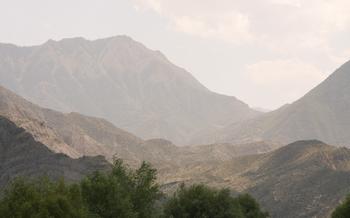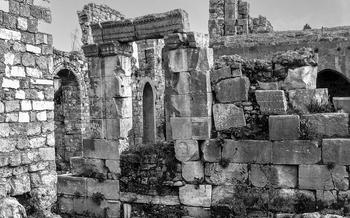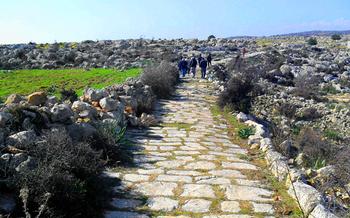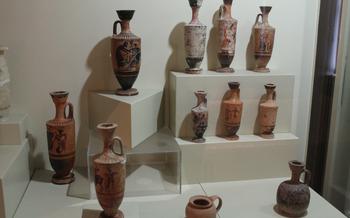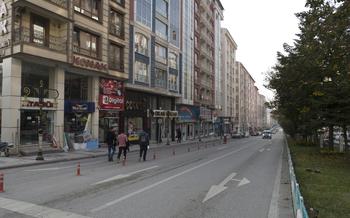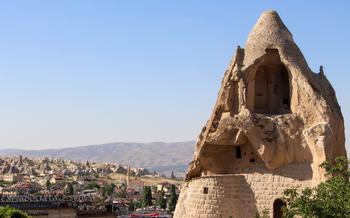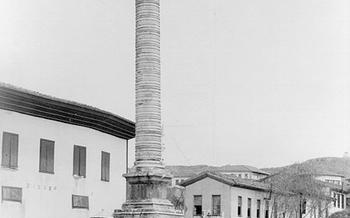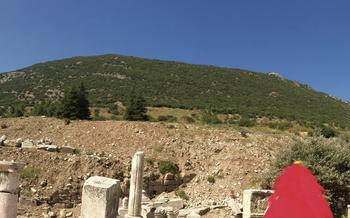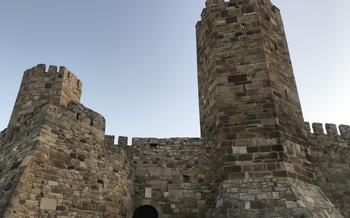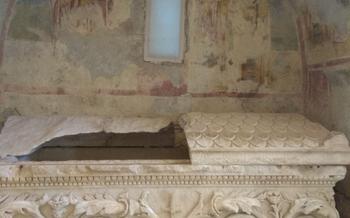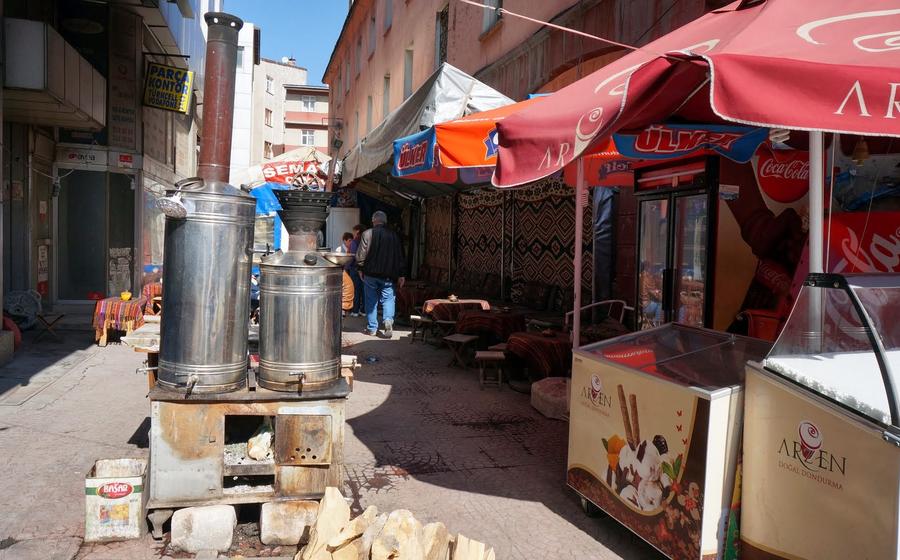
Oltu Stone Museum
- Historical Significance
- Location and Accessibility
- Museum Highlights
- Interactive Experience
- Craftsmanship and Artisanship
- Contemporary Art and Design
- Shopping for Oltu Stone
- Cultural Festivals and Events
- Local Cuisine and Gastronomy
- Historical Sites and Landmarks
- Oltu Stone in Literature and Folklore
- Sustainability and Environmental Impact
- Educational Programs and Workshops
- Photography and Visual Arts
- Insider Tip
Historical Significance
The Oltu Stone, named after the town of Oltu in Erzurum, Turkey, holds a significant place in Turkish culture and history. Its unique characteristics and durability have made it a prized material for centuries. Artisans have skillfully crafted jewelry, decorative objects, and art pieces using Oltu Stone, showcasing its versatility and beauty. The stone's popularity extends beyond aesthetics; it carries cultural and symbolic meanings, representing the region's rich heritage and traditions. Throughout history, the Oltu Stone has been a symbol of love, prosperity, and protection, deeply woven into the fabric of Turkish culture.
Location and Accessibility
The Oltu Stone Museum is conveniently situated in the heart of Erzurum, Turkey, making it easily accessible to visitors. To reach the museum, you can take a leisurely stroll from the city center, allowing you to soak in the vibrant atmosphere and explore the surrounding historical landmarks. Alternatively, if you prefer a more direct route, you can hop on a local bus or taxi that will drop you right outside the museum's entrance. The museum's hours of operation are typically from 9 am to 5 pm, seven days a week, ensuring ample time for visitors to delve into the wonders of the Oltu Stone. The admission fee is nominal and offers excellent value for the immersive experience that awaits you within the museum's walls.
Museum Highlights
The Oltu Stone Museum houses a captivating array of exhibits that showcase the diverse beauty and historical significance of this precious gemstone. Among the highlights of the collection are exquisite pieces of Oltu Stone jewelry, intricately crafted to display the stone's natural brilliance and luster. Visitors can admire necklaces, earrings, bracelets, and rings adorned with vibrant hues of green, blue, and red, showcasing the skill and artistry of local craftsmen.
The museum also features a collection of Oltu Stone sculptures and decorative objects, each piece a testament to the stone's versatility and adaptability. From delicate figurines to ornate vases, these works of art demonstrate the boundless creativity of artisans who have transformed this natural material into objects of enduring beauty.
Interactive displays and educational panels provide visitors with a deeper understanding of the Oltu Stone's geological origins, its cultural significance, and its role in local traditions. Through these exhibits, visitors can learn about the mining and extraction process, the symbolism and beliefs associated with the stone, and its enduring legacy in Turkish culture.
Interactive Experience
The Oltu Stone Museum offers a range of interactive exhibits that engage visitors and provide a deeper understanding of the stone's history and significance. One of the highlights is the "Touch and Feel" exhibit, where visitors can handle and examine different types of Oltu Stone, comparing their textures, weights, and colors. This hands-on experience allows visitors to connect with the stone on a sensory level and appreciate its unique characteristics.
Another interactive exhibit is the "Virtual Reality Journey," which takes visitors on a virtual tour of the Oltu Stone mines and workshops. Using VR headsets, visitors can explore the underground tunnels, witness the extraction process, and learn about the traditional techniques used by skilled artisans. This immersive experience provides a comprehensive overview of the stone's journey from its natural source to its transformation into exquisite jewelry and artwork.
For those interested in trying their hand at Oltu Stone craftsmanship, the museum offers workshops and classes where visitors can learn the basics of jewelry making and stone carving. Under the guidance of experienced artisans, participants can create their own unique pieces of Oltu Stone jewelry, taking home a personalized souvenir and a newfound appreciation for the skill and artistry involved in the process.
Craftsmanship and Artisanship
The Oltu Stone Museum not only showcases the beauty of the stone but also pays homage to the skilled artisans who transform it into exquisite jewelry and artwork. Visitors can learn about the traditional techniques employed by these artisans, passed down from generation to generation. The art of Oltu Stone crafting involves meticulous attention to detail and a deep understanding of the stone's properties.
Artisans use a variety of tools and techniques to shape and polish the stone, creating intricate designs and patterns. The process requires patience, precision, and a keen eye for detail. Visitors can witness the artisans at work, demonstrating their skills and sharing their knowledge of the craft. These live demonstrations offer a unique opportunity to appreciate the artistry and craftsmanship that go into each piece of Oltu Stone jewelry or artwork.
Preserving the cultural heritage of Oltu Stone crafting is of paramount importance. The museum plays a vital role in promoting and supporting local artisans, ensuring that their skills and knowledge are passed on to future generations. By purchasing authentic Oltu Stone products, visitors not only acquire beautiful and unique pieces but also contribute to the sustainability of this traditional craft.
Contemporary Art and Design
The Oltu Stone, with its rich history and cultural significance, has also captured the attention of contemporary artists and designers who are incorporating it into their work in innovative ways. These artists are pushing the boundaries of traditional craftsmanship and creating unique and modern interpretations of the stone.
One notable contemporary artist who has embraced the Oltu Stone is Serdar Gülgün. Gülgün's work often features the stone in combination with other materials, such as metal or glass, creating striking and visually appealing pieces. His jewelry designs, in particular, showcase the stone's versatility and adaptability to modern aesthetics.
Another artist who has found inspiration in the Oltu Stone is Aylin Tüfekçi. Tüfekçi's sculptures explore the stone's organic forms and textures, creating abstract and minimalist pieces that evoke a sense of tranquility and balance. Her work has been exhibited in galleries around the world and has garnered critical acclaim for its innovative approach to stone sculpture.
These contemporary interpretations of the Oltu Stone are not only aesthetically pleasing but also serve to keep the stone relevant in the modern world. By incorporating it into their work, artists are introducing the Oltu Stone to a new audience and ensuring its cultural significance continues to endure.
Shopping for Oltu Stone
When visiting Erzurum, discerning travelers seeking authentic Oltu Stone jewelry and artwork should venture into the vibrant local markets and shops. The city boasts a plethora of reputable establishments specializing in Oltu Stone products, ensuring visitors can find unique and genuine pieces.
One such gem is the Oltu Stone Bazaar, a bustling marketplace where artisans and vendors showcase their exquisite creations. Here, visitors can browse a dazzling array of jewelry, from intricate necklaces and earrings to elegant rings and bracelets, all adorned with the distinctive Oltu Stone. Skilled craftsmen meticulously handcraft each piece, ensuring the utmost quality and attention to detail.
For those seeking a more personalized experience, workshops and studios scattered throughout the city offer visitors the opportunity to witness the artistry firsthand. Artisans passionately demonstrate their traditional techniques, transforming raw Oltu Stone into stunning masterpieces. Visitors can engage in interactive workshops, learning the art of jewelry making and creating their own unique pieces to cherish as a lasting memento of their visit.
When purchasing Oltu Stone products, it is crucial to support local artisans and ensure the authenticity of the items. Look for the distinctive Oltu Stone hallmark, which guarantees the stone's origin and quality. By supporting local artisans, visitors not only acquire exquisite souvenirs but also contribute to preserving the region's rich cultural heritage.
Cultural Festivals and Events
The Oltu Stone is celebrated and showcased in Erzurum through various cultural festivals and events that bring the region's heritage to life. One of the most prominent is the Oltu Stone Festival, held annually in the city of Oltu, where the stone originated. This vibrant festival attracts visitors from near and far to immerse themselves in the rich traditions and craftsmanship associated with the Oltu Stone.
During the festival, the streets come alive with colorful parades, traditional music and dance performances, and lively demonstrations of Oltu Stone carving and jewelry-making by local artisans. Visitors can witness the intricate skills of master craftsmen as they transform the stone into exquisite pieces of art, showcasing the centuries-old techniques that have been passed down through generations.
The Oltu Stone Festival also features a vibrant marketplace where vendors display and sell a diverse range of Oltu Stone jewelry, artwork, and souvenirs. This provides an excellent opportunity for visitors to purchase authentic and unique pieces while supporting the local artisans who keep the tradition alive.
By participating in these cultural festivals and events, visitors can gain a deeper appreciation for the Oltu Stone's history, cultural significance, and the vibrant community that surrounds it. The Oltu Stone Festival is a must-attend event for anyone interested in experiencing the authentic culture and heritage of Erzurum and the Oltu Stone.
Local Cuisine and Gastronomy
The Oltu Stone plays a unique role in the local cuisine and gastronomy of Erzurum. Traditionally, the stone has been used for centuries to make mortars and pestles, which are essential tools for grinding spices, grains, and other ingredients. The porous nature of the stone helps to create a smooth and even texture, enhancing the flavors and aromas of the ground ingredients.
One of the most famous dishes associated with the Oltu Stone is "oltu taşı dövülmüş keşkek," a traditional Turkish dish made from pounded wheat and meat. The wheat is first soaked and then pounded using an Oltu Stone mortar and pestle until it reaches a smooth and creamy consistency. The meat is then added and cooked together with the pounded wheat, creating a hearty and flavorful dish.
In addition to its use in traditional dishes, the Oltu Stone is also finding its way into modern culinary creations. Contemporary chefs and restaurateurs are experimenting with the stone's unique properties to create innovative dishes and presentations. For example, some chefs are using Oltu Stone plates and bowls to serve food, taking advantage of the stone's natural ability to retain heat and cold. Others are using the stone to create unique flavor infusions, such as by marinating meats or vegetables on Oltu Stone slabs.
By incorporating the Oltu Stone into local cuisine, Erzurum's culinary scene not only celebrates the region's cultural heritage but also showcases the stone's versatility and adaptability to modern culinary trends.
Historical Sites and Landmarks
The Oltu Stone is deeply intertwined with the history and cultural heritage of Erzurum. Several historical sites and landmarks in the city are closely associated with the stone's significance. One notable site is Oltu Castle, an ancient fortress that once served as a strategic defense point. The castle walls are adorned with intricate carvings and engravings featuring the Oltu Stone, showcasing its use in architectural embellishments. Another must-visit destination is the Erzurum Archaeological Museum, which houses a collection of artifacts and exhibits related to the region's history. Among the highlights of the museum is a stunning display of Oltu Stone jewelry, pottery, and decorative objects, providing visitors with a glimpse into the craftsmanship and artistry of the past. Incorporating these historical sites into your tour will deepen your understanding of the Oltu Stone's role in shaping Erzurum's rich history and cultural tapestry.
Oltu Stone in Literature and Folklore
The Oltu Stone has a rich presence in Turkish literature, folklore, and mythology, symbolizing beauty, craftsmanship, and cultural heritage. Throughout history, the stone has been referenced in stories, legends, and traditional tales, embodying the essence of the region and its people.
One notable example is the epic tale of "Köroğlu," a legendary figure in Turkish folklore. In the story, Köroğlu is said to have possessed a magnificent Oltu Stone ring that granted him strength and courage, symbolizing his heroic qualities and connection to the land.
Another famous legend associated with the Oltu Stone is the story of "The Forty Martyrs of Sebaste." According to tradition, these forty Christian soldiers were martyred in Erzurum during the Roman persecutions. It is said that their blood seeped into the Oltu Stone, giving it a unique reddish hue, and the stone is revered as a symbol of their sacrifice and resilience.
In modern Turkish literature, the Oltu Stone has been featured in the works of renowned authors such as Yaşar Kemal and Orhan Pamuk. Kemal's novel "The Legend of the Thousand Bulls" includes a character who inherits a valuable Oltu Stone necklace, representing the continuity of cultural traditions and the enduring significance of the stone in Turkish society.
These literary and folkloric references to the Oltu Stone not only showcase its cultural importance but also contribute to the preservation and transmission of the region's rich heritage for future generations.
Sustainability and Environmental Impact
The Oltu Stone industry recognizes the importance of sustainability and takes steps to minimize its environmental impact. Responsible mining practices are employed to ensure the preservation of the natural landscape and ecosystem. Mining activities adhere to strict regulations to prevent soil erosion, water pollution, and habitat destruction.
Efforts are made to reduce waste and promote recycling of Oltu Stone byproducts. Artisans and manufacturers utilize innovative techniques to minimize the amount of stone waste generated during the production process. Recycling programs are in place to repurpose leftover materials and create new products.
Sustainability certifications are sought after by Oltu Stone producers to demonstrate their commitment to ethical and environmentally friendly practices. These certifications ensure that the stone is sourced responsibly and that production processes meet strict environmental standards.
By embracing sustainability, the Oltu Stone industry ensures the preservation of this precious resource for future generations while protecting the natural environment for the benefit of both the local community and visitors alike.
Educational Programs and Workshops
The Oltu Stone Museum and other institutions offer educational programs and workshops that delve deeper into the history, cultural significance, and craftsmanship associated with the stone. These programs are designed to educate and engage visitors of all ages, fostering a greater appreciation for the Oltu Stone heritage.
One of the most popular programs is the "Oltu Stone Jewelry Making Workshop," where participants learn the traditional techniques used to craft exquisite jewelry pieces from raw Oltu Stone. Under the guidance of experienced artisans, visitors can create their own unique pendants, rings, or earrings, taking home a personalized souvenir of their time in Erzurum.
For those interested in the history and cultural significance of the stone, the museum offers guided tours and lectures that explore the stone's origins, its role in Turkish culture, and its connection to the region's identity. These tours provide a deeper understanding of the Oltu Stone beyond its aesthetic appeal.
Additionally, the museum hosts regular workshops on Oltu Stone carving and engraving, where participants can learn the intricate techniques used to create decorative objects, sculptures, and even functional items such as bowls and plates. These workshops offer a hands-on experience that allows visitors to create their own unique pieces while gaining insights into the artistry and craftsmanship involved in Oltu Stonework.
Whether you're a history buff, an aspiring artist, or simply curious about the Oltu Stone, these educational programs and workshops provide a unique opportunity to engage with the stone's heritage and create lasting memories of your visit to Erzurum.
Photography and Visual Arts
The Oltu Stone, with its captivating textures, vibrant colors, and intricate patterns, presents a compelling subject for photography and visual arts. Its unique characteristics have inspired artists to capture its essence through various mediums, transforming the stone into a canvas for creative expression.
Photographers are drawn to the Oltu Stone's ability to reflect light and create striking contrasts. The stone's natural imperfections, such as cracks and inclusions, add depth and character to images, making each piece a unique work of art.
Visual artists, on the other hand, find inspiration in the stone's malleability and versatility. Sculptors transform the Oltu Stone into intricate carvings and sculptures, showcasing the stone's ability to convey emotions and narratives. Painters and illustrators capture the stone's essence through vibrant brushstrokes and delicate lines, creating colorful representations that bring the stone's beauty to life.
Exploring the Oltu Stone through photography and visual arts allows visitors to appreciate its aesthetic qualities and cultural significance from a different perspective. Whether capturing the stone's raw beauty in a photograph or transforming it into a work of art, these artistic interpretations celebrate the Oltu Stone's enduring legacy and inspire a deeper appreciation for its unique charm.
Insider Tip
As a travel blogger who has extensively explored Erzurum and its hidden gems, I would like to share a personal anecdote that highlights the true essence of the Oltu Stone Museum. During my visit, I had the privilege of meeting a local artisan named Mehmet, who has dedicated his life to crafting exquisite Oltu Stone jewelry. Mehmet warmly invited me into his workshop, where I witnessed firsthand the intricate process of transforming raw stones into beautiful masterpieces. He shared stories of his family's generations-long involvement in the craft and the deep connection they feel to the Oltu Stone. Mehmet's passion and artistry left a lasting impression on me, and I highly recommend visitors to seek out local artisans and engage with them to gain a deeper understanding of the cultural significance of the Oltu Stone.
